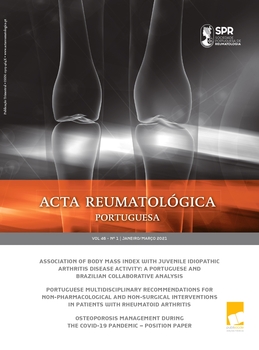Thiol/disulphide homeostasis in patients with rheumatoid arthritis: a potential link between disease activity and preclinical atherosclerosis
Authors
Münevver Serdaroglu Beyazal; Medeni Arpa; Gül Devrimsel; Murat Yıldırım; Özcan Erel; Turan Erdogan;
Introduction/objectives: Thiols are crucial anti-oxidant agents that contain a sulfhydryl group; they play an important role in defence against reactive oxygen species. We aimed to determine the thiol/disulphide homeostasis in rheumatoid arthritis (RA) patients in conjunction with its association with disease activity, preclinical atherosclerosis, and other disease-related indices.
Methods: We enrolled 64 RA patients without known cardiovascular (CV) disease or risk factors and 46 healthy controls. Disease activity was evaluated using the Disease Activity Score 28-erythrocyte sedimentation rate (DAS28-ESR). Thiol/disulphide homeostasis was evaluated using a novel automated method, and serum native thiol (NT), total thiol (TT), and disulphide(SS) levels were recorded. The carotid intima media thickness (CIMT) was measured using carotid ultrasound to evaluate preclinical atherosclerosis.
Results:The NT and TT levels were significantly lower in RA patients than in controls (231.7 ± 52.3 vs. 293.6 ± 74.8 µmol/L, p < 0.001; 271.6 ± 52.1 vs. 331.3 ± 68.2 µmol/L, p < 0.001, respectively). There was no difference in SS levels between both groups. The CIMT was significantly higher in RA patients than in controls (0.80 vs. 0.56 mm, p ˂ 0.001). NT levels showed a significant negative correlation withCIMT in patients with RA (r = - 0.253, p = 0.040). In RA patients, NT and TT levels were significantly correlated with ESR (r = - 0.394, r = -0.399), high-sensitivity C-reactive protein (r = -0.413, r = - 0.342), DAS28-ESR (r = - 0.279, r = - 0.312), fibrinogen level (r = - 0.302, r = - 0.346), and anti-cyclic citrullinated peptide titres (r = - 0.305, r = 0.322) (, respectively). The association of thiol levels with CIMT did not arrive at a statistically significant level in multivariable linear regression analysis.
Conclusions: RA patients without known CV disease or risk factors exhibited increased CIMT values and decreased thiol levels; moreover, thiol levels were found to be correlated with disease activity. Further studies are needed to detect the value of thiol/disulphide homeostasis for CV risk stratification and risk prediction in RA patients.
Münevver Serdaroglu Beyazal
Department of Physical Medicine and Rehabilitation, Faculty of Medicine, Recep Tayyip Erdoğan University
Medeni Arpa
Department of Biochemistry, Faculty of Medicine, Recep Tayyip Erdoğan University
Gül Devrimsel
Department of Physical Medicine and Rehabilitation, Faculty of Medicine, Recep Tayyip Erdoğan University
Murat Yıldırım
Department of Physical Medicine and Rehabilitation, Faculty of Medicine, Recep Tayyip Erdoğan University
Özcan Erel
Department of Clinical Biochemistry, Faculty of Medicine, Yıldırım Beyazıt University
Turan Erdogan
Department of Cardiology, Faculty of Medicine, Recep Tayyip Erdoğan University
Department of Physical Medicine and Rehabilitation, Faculty of Medicine, Recep Tayyip Erdoğan University
Medeni Arpa
Department of Biochemistry, Faculty of Medicine, Recep Tayyip Erdoğan University
Gül Devrimsel
Department of Physical Medicine and Rehabilitation, Faculty of Medicine, Recep Tayyip Erdoğan University
Murat Yıldırım
Department of Physical Medicine and Rehabilitation, Faculty of Medicine, Recep Tayyip Erdoğan University
Özcan Erel
Department of Clinical Biochemistry, Faculty of Medicine, Yıldırım Beyazıt University
Turan Erdogan
Department of Cardiology, Faculty of Medicine, Recep Tayyip Erdoğan University





